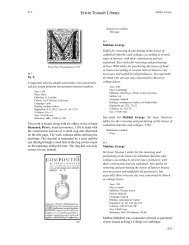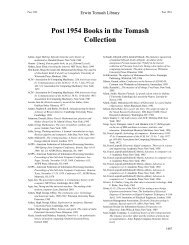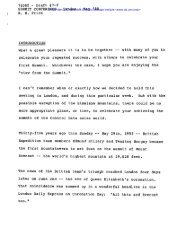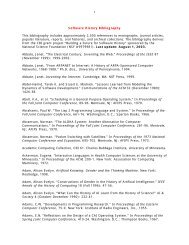B chapter.indd - Charles Babbage Institute - University of Minnesota
B chapter.indd - Charles Babbage Institute - University of Minnesota
B chapter.indd - Charles Babbage Institute - University of Minnesota
You also want an ePaper? Increase the reach of your titles
YUMPU automatically turns print PDFs into web optimized ePapers that Google loves.
Erwin Tomash Library<br />
Blagrave, John Blagrave, John<br />
servants selected by town parishes who were to cast lots<br />
for their prize money each Good Friday.<br />
The instrument described is a planispheric astrolabe that<br />
had a universal projection modified from the Catholicon<br />
<strong>of</strong> Gemma Frisius—a description <strong>of</strong> which can be<br />
found in the second booke. Blagrave added a movable<br />
rete (<strong>of</strong>ten found on standard astrolabes but not on the<br />
Catholicon), which simplified its use for astronomical<br />
calculations. This astrolabe was universal in the sense<br />
that it did not require a number <strong>of</strong> different plates or<br />
maters to be used at different latitudes. The instrument<br />
is illustrated in a number <strong>of</strong> full-page engravings serving<br />
as frontispieces to the work—engraved by the author<br />
according to the title page. This was an expensive<br />
instrument to build and consequently was not much<br />
used. While this is the only edition <strong>of</strong> this work, the<br />
Jewel was described ten years later in a work by Thomas<br />
Blundeville (Exercises, 1622), and instruction in its use<br />
was also <strong>of</strong>fered by Robert Hartwell, a London teacher<br />
<strong>of</strong> mathematics, in 1623 (see Waters, David Watkin; Art<br />
<strong>of</strong> navigation, 1958, p. 570).<br />
B 174<br />
Arc drawing instrument, B 174<br />
Mathematical jewel, B 174<br />
The work is divided into six bookes. The first deals with<br />
elementary concepts <strong>of</strong> astronomy; the second with<br />
the design and manufacturing <strong>of</strong> the jewel; the third<br />
with the use <strong>of</strong> the instrument for both navigation and<br />
astronomical calculations; the fourth considers the same<br />
material as the third, but the examples and methods <strong>of</strong><br />
working come from Blagrave’s own research; the fifth<br />
is a treatise on spherical triangles; and the last is a work<br />
on the use <strong>of</strong> the jewel in creating sundials <strong>of</strong> all types.<br />
For such a small volume, it is remarkably complete and<br />
would have made a very useful reference work even<br />
if one did not have a jewel to use. In the fourth book,<br />
Blagrave mentions that he had made a jewel two feet in<br />
diameter and that he had problems drawing all the arcs<br />
on it. He then illustrates a drawing instrument that would<br />
suffice in such a situation.<br />
Blagrave is known to have made other instruments,<br />
in particular a familiar staff, which may have been an<br />
instrument for artillerymen.<br />
The work contains a handwritten note which reads:<br />
Here stands Mr. Gray master <strong>of</strong> this house<br />
And his poor catt playing with a mouse.<br />
John Balgrave marred this Grayes widdow (She was a<br />
Hungerford) this John was symple had yssue by the widdowe<br />
1 Anthony who marryed Jane Borlafs. 2 John the author <strong>of</strong><br />
the booke. 3 Alexander the excellent chess player in England.<br />
Anthony had Sir John Blagrave knight who caused his teeth to<br />
be all drawn out and after had a sett <strong>of</strong> ivory teeth in agayne.<br />
157







